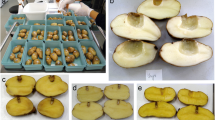Abstract
When 1-mo-old plants of a wilt-resistant clone ofSolanum phureja (1386.15) were stem-inoculated with three strains ofPseudomonas solanacearum (K60, S123, and S206), the bacteria multiplied rapidly at the point of inoculation and then moved in the vascular system to other parts of the stem. Resistant plants showed a remarkable ability to support relatively high populations of the bacterium in the absence of disease symptoms. Although multiplication in this resistant clone was substantially less than in susceptible Russet Burbank potato plants, large numbers of bacteria (up to 624 × 104 cells of K60 per 5-cm stem segment) reached the base of the stem of plants maintained at high temperature (28°C) for 20 days after stem inoculation. From the base of the stem, the bacteria moved rapidly into the roots and tubers. Strains ofP. solanacearum differed in their ability to cause latent tuber infection in different resistant potato clones. When 11S.phureja ×S. tuberosum hybrids were stem-inoculated, maintained at 28°C for 3 wk and then grown to maturity at 20°C., most of the clones yielded tubers infected by one or more strains. The race 1 strain (K60) was the most infectious; 53.8% of all tubers harvested from all plants inoculated with this isolate carried latent infections. Because one clone (BR 53.1) never yielded infected tubers, there appear to be genetic factors which may be useful in breeding programs aimed at eliminating latent tuber infection.
Resumen
Cuando se inocularon plantas de 1 mes de edad del clon deSolanum phureja, 1886.15 (resistente) con tres cepas dePseudomonas solanacearum (K60, S123 y S206) las bacterias se multiplicacion rápidamente en el lugar de la inoculación y se esparcieron en el tallo por medio de los haces vasculares. Aunque la multiplicación en este clon resistente fué mucho menor que en una planta de papa susceptible, como Russet Burbank, la población de bacterias alcanzó 624 × 104 células por segmento de 5 cm de largo de tallo en la base de plantas mantenidas a una temperatura alta (28°) por 20 días. De la base del tallo, la bacteria se esparció rápidamente a las raíces y tubérculos. Diferentes cepasde P. solanacearum difirieron en su abilidad de causar infecciones latentes en los tubérculos de clones resistentes. Cuando se inocularon 11 híbridos deS. phureja × S. tuberosum en los tallos y las plantas se mantuvieron a 28°C por 3 semanas y luego se dejaron madurar a 20°C., casi todos los clones produjeron tubérculos infectados por una o más cepas. La cepa de raza 1, K60 fué la más infecciosa; 53.8% de todos los tubérculos producidos por todas las plantas inoculadas resultaron infectados por esta bacteria. Como uno de los clones resistentes (BR 53.1) nunca produjo tubérculos infectados, se sugiere que esta es una característica genética que puede ser muy útil en programas de mejoramiento en que se intente eliminar el problema de infecciones latentes en los tubérculos.
Similar content being viewed by others
Literature Cited
Copeman, R.J. 1969. Histological and cytochemical changes in tobacco infected byPseudomonas solanacearum. Ph.D. Thesis, Univ. of Wisconsin. 94 pp.
French, E. 1972. Progress and problems in selecting resistance to bacterial wilt. Pages 212–214. In Prospects for the Potato in the Developing World; ed. E.R. French. International Potato Center, Lima, Peru.
González, C. 1977. Determinación de niveles de infección porPseudomonas solanacearum en tubérculos de semilla de papa. Fitopatología 12:101–104.
González, L.C., L. Sequeira and P.R. Rowe. 1973. A root inoculation technique to screen potato seedlings for resistance toPseudomonas solanacearum. Am Potato J 50:96–104.
Graham, J., D.A. Jones and A.B. Lloyd. 1979. Survival ofPseudomonas solanacearum race 3 in debris and latently infected potato tubers. Phytopathology 69:1100–1103.
Granada, G.A., and L. Sequeira. 1975. A hypersensitive reaction induced in tobacco leaves by a compatible (race 1) isolate ofPseudomonas solanacearum. Phytopathology 65:731–733.
Grieve, B.J. 1943. Studies in the physiology of host-parasite relations. III. Factors affecting resistance to bacterial wilt of Solanaceae. Proc R Soc Victoria, N. S. 55:13–40.
Hayward, A.C. 1964. Characteristics ofPseudomonas solanacearum. J Appl Bacteriol 27:265–279.
Hayward, A.C. 1976. Systematics and relationships ofPseudomonas solanacearum. Pages 6–21. In Proc. 1st Int. Planning Conf. and Workshop on the Ecology and Control of Bacterial Wilt Caused byPseudomonas solanacearum; eds. L. Sequeira and A. Kelman. North Carolina State University, Raleigh.
International Potato Center, Lima, Peru. 1979. New variety Molinera reaches the farmer. CIP Circular 7 (10). 3 pp.
Kelman, A. 1953. The bacterial wilt caused byPseudomonas solanacearum. North Carolina Agric Exp Stn Tech Bull 99, 194 pp.
Kelman, A. 1954. The relationship of pathogenicity inPseudomonas solanacearum to colony appearance on a tetrazolium medium. Phytopathology 44:693–695.
Rowe, P.R., and L. Sequeira. 1970. Inheritance of resistance toPseudomonas solanacearum inSolanum phureja. Phytopathology 60:1499–1501.
Rowe, P.R., L. Sequeira and L.C. González. 1972. Additional genes for resistance toPseudomonas solanacearum inSolanum phureja. Phytopathology 62:1093–1094.
Sequeira, L., and P.R. Rowe. 1969. Selection and utilization ofSolanum phureja clones with high resistance to different strains ofPseudomonas solanacearum. Am Potato J 46:451–462.
Thurston, H.D. 1963. Bacterial wilt of potatoes in Colombia. Am Potato J 40:381–390.
Wallis, F.M., and S.J. Truter. 1978. Histopathology of tomato plants infected withPseudomonas solanacearum with emphasis on ultrastructure. Physiol Plant Path 13:307–317.
Wang, G.W. 1937. The entrance and migration ofBacterium solanacearum Smith in tobacco plants. Ann Phytopath Soc Japan 7:14–23.
Winstead, N.N., and A. Kelman. 1952. Inoculation techniques for evaluating resistance toPseudomonas solanacearum. Phytopathology 42:628–634.
Author information
Authors and Affiliations
Additional information
Research supported by the College of Agricultural and Life Sciences, University of Wisconsin-Madison (Project 1481) and by a grant from the International Potato Center, Lima, Peru.
Rights and permissions
About this article
Cite this article
Ciampi, L., Sequeira, L. Multiplication ofPseudomonas solanacearum in resistant potato plants and the establishment of latent infections. American Potato Journal 57, 319–329 (1980). https://doi.org/10.1007/BF02854027
Received:
Issue Date:
DOI: https://doi.org/10.1007/BF02854027




